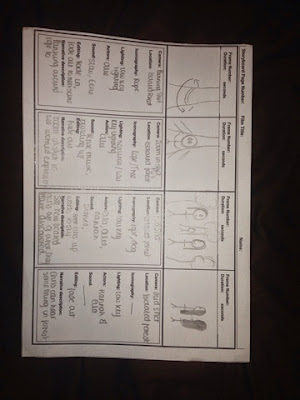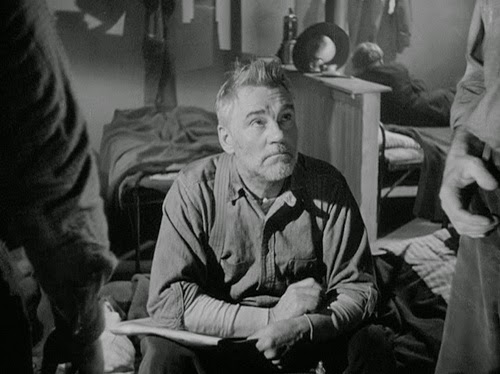Individual Storyboard
A story board is a series of pictures and drawings which are explained in detail. In media however we have drawn pictures of our scenes and explained in detail about them such as the lighting that will be used, the iconography within the scene and editing styles. The sequence helps to show the scenes that you have envisioned.
This is an example of what a story board is set out like:
Here is my own individual storyboard:
Within my group, all three of us will create individual story boards as this helps us to broaden and expand our ideas as we will incorporate each others individual ideas to make it as good as it can be. This will ensure that we have planned as well as we possibly can because there is three people working together instead of just one, somebody could come up with an idea that would make the scene altogether much more interesting, which could keep the audience wanting to watch on.
When planning I hope that my individual storyboard helps towards the final storyboard of my groups as we can select ideas that I have come up with but expand and change them slightly to make them more suitable for the opening sequence that we want to achieve.
Within my storyboard I have drawn out the general idea of my opening thriller sequence of which shots I would like to include. The scene begins with a news report about missing children within the local area. The scene then fades and moves on to the two girls heading towards the forest to take their dogs on a walk. The two girls then enter the forest and hear sounds of rustling and whistling of the wind. The girls then turn round to see the dark figure. This is followed by over the shoulder shots to give the two girls and gives their point of view. You then lead on to see the two girls in a long shot directly seeing the dark figure. I have then drawn a couple of boxes with drawings to show that it is a montage clip, which is a series of scenes edited together. The scenes will consist of going back to the girls, the dark figure, trees, and the sky, this gives an ultra-heightened expectation which helps to build the suspense and tension. The final scene I have drawn is the two girls looking up and seeming possessed. This leaves the scene ending on a cliff hanger and the audience would want to watch on further to know what has happened.
I have included many elements into my storyboard of my opening thriller sequence. This includes low key lighting, point of view shots, zooming in shots. The purpose of low key lighting is to help add and create suspense to the scene as it is unknown what could appear within the dark lighting and gives a sense of vulnerability to the character as they are defenseless with poor vision and could jeopardize their safety and endanger them. This makes the audience feel sympathy for the character as they can only imagine how the character must be feeling. We will also use a point of view shot within our opening thriller sequence this is when the camera represents what someone is looking at, this can be used as a direct shot where the camera is looking at something or as a over the shoulder shot where it looks as though the two characters are having a conversation and you are seeing it from one of the characters point of view. Another shot that we will definitely be using is the use of reaction shot. This is because it helps to set the scene as you can clearly see the characters expressions and emotions, this helps make the audience sympathize for the characters as they begin to imagine themselves in this situation.
I hope that the audience will be kept in suspense from my opening sequence. I hope this because of the cliff hanger ending where the audience are left wondering what has happened to the girls, if they are in danger, and what will happen to them next. Not only this, but I hope that the audience will also be shocked and surprised at some scenes, also feeling sympathetic to the characters. This could possibly be from the scene were they see the young boy tied up to the tree. This will make the audience shocked as this is something unusual that you would see in a forest, and are wondering why it has happened. Not only this but the audience will sympathize for the character as our target audience is of a similar age range as the characters so they cant help but imagine themselves in the characters situation and how scared they would also be feeling.
All three of us have come up with different ideas for a storyboard. However, we will incorporate each others ideas into one, to produce a storyboard in which we all think will work best and create the best idea that we can. An example of incorporating each others work is Ella's beginning black screen which fades in to a news report. Whereas my idea was to film a TV, with a new report voice over on top. However, we have incorporated both these ideas and have now decided to have a black screen, with a voice over of a new report on top, this allows the audience to follow and understand what is being said, so they then have an idea of what is going to happen within the sequence. Another idea that we have incorporated together is the fact of the few scenes of the girls looking round for the dark figure, then seeing the dark figure up close, we have decided instead to use a point of view shot in the form of an over the shoulder shot to show that the girls have now seen the dark figure.
Our opening thriller sequence is the narrative which would be at the end of our film. We decided to do this because the audience will watch this, and want to know the entire story line leading up to the events that have been seen in the sequence. This has shown disequilibrium as we have shown the end at the beginning of our opening sequence. We believe that this will entice our target audience and make them want to watch on further.
Overall I think that my storyboard gives a clear understanding of what myself and my group aim to film and create in our opening thriller sequence. It has helped to show what scenes are going where and what is going to be filmed. However, some issues have been identified as my group has discussed our individual storyboards when trying to produce a final storyboard that we have all put together. One issue is we have decided that we would like to add additional scenes into the sequence, which is easily solved as we can add in the extra scenes, whilst removing some of the scenes that we have also decided will not work with the sequence we are trying to create or are not relevant anymore to the storyline. Lastly, some scenes may have been difficult to film, so we have changed the scene so that we can film what we need to. An example of this was we were going to use a high angled shot within the forest, but realized it would be very difficult to get this shot, so have considered using a low angled shot of the forest as this will be much more convenient and easier to film.
By planning out my opening thriller sequence by using a storyboard this has helped to not only plan out which scene goes where, but this will ensure organisation when we come to filming. This is important and helpful as we will not be questioning, where we will be filming and what we will be filming as we would have already discussed it, saving more time for filming the scenes.














.jpg)












